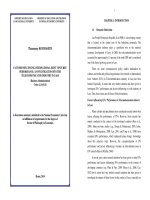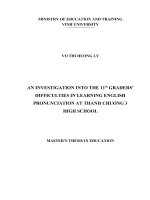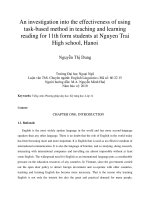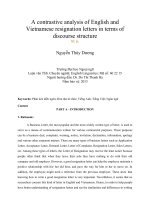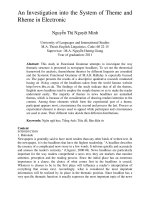Factors influencing international joint ventures'' performance An investigation into the telecommunication industry in Laos.PDF
Bạn đang xem bản rút gọn của tài liệu. Xem và tải ngay bản đầy đủ của tài liệu tại đây (282.23 KB, 26 trang )
MINISTRY OF EDUCATION AND TRANING
MINISTRY OF EDUCATION AND SPORT
NATIONAL ECONOMICS UNIVERSITY
NATIONAL UNIVERSITY OF LAOS
VIETNAM
LAOS
THANSAMAY KOMMASITH
FACTORS INFLUENCING INTERNATIONAL JOINT
VENTURES’ PERFORMANCE: AN INVESTIGATION INTO
THE TELECOMMUNICATON INDUSTRY IN LAOS
(Business Administration)
Code: 62.34.01.02
A dissertation Summary Submitted to the National Economics
University, Vietnam and National University of Laos in fulfillment of
requirements for the degree of Doctor of Philosophy in Economics
Hanoi, 2014
The dissertation was completed at the National Economics
University, Hanoi, Vietnam
Supervisor: Assoc. Prof. Dr. Nguyen Thi Tuyet Mai.
The 1st commentator:
Assoc. Prof. Dr. Nguyen Van Thang - National Economics
University
The 2nd commentator:
Assoc. Prof. Dr. Phouthet KYOPHILAVONG - National
University of Laos
The 3rd commentator:
Dr. Phi Vinh Tuong - Vietnam Institute of Economics
The dissertation will be defended against the council of dissertation
assessment in National Economics University, Hanoi, Vietnam (or
National University of Laos)
at (hour)
date
month
year
The dissertation is available at the libraries:
-
The National Library of Vietnam
-
The Library of National Economics University, Hanoi, Vietnam
-
The Library of National University of Laos
1
CHAPTER 1: INTRODUCTION
1.1
Research Motivation
Lao People Democratic Republic (Lao PDR) is a developing country
that is located in the central part of the Indochina peninsula. The
telecommunication industry plays a significant role in the national economic
development of Laos. In 2008, the telecommunications sector accounted for
approximately 1.6 percent of the total GDP and is considered one of the
fastest growing sectors in Laos.
There are some communication policy studies undertaken by scholars
and media and political organization, but research on International Joint
Ventures (IJVs) in Telecommunication industry in Laos has been limited.
Especially, it seems that very modest attention has been given to investigate
IJVs’ performance and factors influencing it in the industry in Laos. Thus,
these issues are the focus of this dissertation.
Factors influencing IJVs’ Performance in Telecommunication Industry in
Laos
Many scholars and practitioners have conducted research about what
factors affecting the performance of IJVs. However, their research has mainly
conducted in the context of the developed countries (Ren et al., 2009). Many
previous studies (e.g., Hoang & Rothaermel, 2005; Isobe, Makino, &
Montgomery, 2000; Luo, 2001; and Tong et al., 2008) have examined IJVs
performance, which enhanced human beings’ knowledge about this attractive
topic. However, the conceptualization of IJV performance and factors
influencing it remains an often-debated issue in IJV research (Reus &
Ritchie, 2004).
2
In recent years, more research attention has been given to study IJVs
performance and factors influencing IJVs performance in the context of
developing countries (e.g. Phan & Ngo, 2009; Phan et al., 2006; Cao, 2012)
but it seems that very modest research attention has been given to investigate
the impact of these factors in the context of Laos, especially no study has
examined the issue in the Telecommunication industry in Laos. In other
words, this attractive topic has not been investigated adequately in the
context of Laos, especially in the telecommunication sector.
For facilitating the sustainable development and ensure the success of
IJVs in the important fields like the telecommunication industry in Laos, it is
very essential to have better understanding of the current status of the IJVs’
performance and investigate the determinants of the IJVs’ success or failure.
Research objectives and questions
While focusing on the main objective of investigating the impact of
several factors on performance of the IJVs in telecommunication industry in
Laos, this study aims to answer the following questions:
1.
What is the overall picture of business performance of IJVs in
Lao’s telecommunication industry regarding different aspects of performance
based on the theoretical framework?
2.
What are the key factors influencing the performance of the IJVs
in the telecommunication industry in Laos and what are the impacts of these
factors on the IJVs’ performance?
In terms of the research scope, the data collected for this study mainly
from the three IJVs in the telecommunication industry in Laos.In terms of
timing, the collected data mainly cover recent three years (from 2010 to
date). The analyses focus on several aspects of IJV’s performance and the
factors influencing it. The primary data mainly focus on the perspective from
3
Lao’s partners in the IJVs.
1.2
Theoretical background
This study employs the theoretical background regarding IJVs
performance and factors influencing their performance (e.g., Cao, 2012, Ren
et al., 2009, Bener & Glaister, 2010). On the basis of literature review,
performance of IJVs has been assessed through some measurement variables,
such as: survival, financial output, overall satisfaction, achievement of
individual or joint goals, and learning.
Many previous studies have identified that IJVs performance has been
influenced by many factors. These factors include control of parent firms,
trust, autonomy, national culture differences, corporate culture differences
(Bener & Glaister, 2010; cf., Ren et al., 2009), commitment, bargaining
power, justice, conflict, effectiveness of conflict resolution, cooperation, and
goal compatibility (cf., Ren et al., 2009).
1.3
Research methodology
This study employed the case study method. Both secondary data and
primary data were collected to develop the three case studies in order to
reflect IJVs’ performance and the factors influencing their performance
during the time of the research. As this study mainly aims to analyze factors
influencing FDI companies’ performance in the selected cases, multiple data
collection methods were used to increase credibility and validity.
Specific data collection methods used in this study include desk
research (for collecting secondary data), observation, interviews (both faceto-face and by telephone), and survey (for collecting primary data).
1.4
Contribution of the Study
This study aims to examine several dimensions of the IJVs’
performance and to explore the impact of the key factors on the IJVs’
4
performance in the context of Lao’s telecommunication industry.
The topic of this study is important and interesting that have attracted
much attention from previous studies. This study contributes to the literature
pertaining to IJVs’ performance and factors influencing them in the context
of Laos, a developing country that has received very modest research
attention up to date.
The findings of this study help to enrich the knowledge about this
important topic by investigating simultaneously the key dimensions of IJV
performance. Specifically, all five performance dimensions were examined in
the context of the telecommunication industry in Laos, including Survival
and Longevity of the IJV, Financial Performance/financial output measures,
Overall Satisfaction, IJV’s Goal Achievement, and Learning.
This study also explored the main factors influencing IJV performance
and empirically tested the impact of these factors in four regression models.
In addition, with the case study method used in this study, multiple data
sources were employed including secondary data (i.e., data collected from
internet, company reports, etc.) and primary data sources (i.e., data collected
from observation, in-depth interviews, and survey). This method was useful
and necessary to obtain better understanding the research issues.
Some managerial implications are drawn from the findings of this study.
Specifically, the findings provide IJVs’ managers with knowledge and insight
that would help better understand and manage the determinants of IJV
performance, and therefore help improve performance of IJVs.
This study is expected to provide some implications for policy makers in
an attempt to create a better business environment and to ensure the favorable
conditions for IJVs to achieve better performance in Laos. For the benefit of
Lao’s economy and society at large, the local government may want to work
5
together with investors (both local and foreign partners) to jointly develop
successful IJVs.
1.5
Organization of the Study
This dissertation includes five main chapters as follows.
Chapter 1: Introduction
Chapter 2: Literature review and conceptual framework
Chapter 3: Research methodology
Chapter 4: Research findings
Chapter 5: Conclusions and discussion
6
CHAPTER 2: LITERATURE REVIEW AND CONCEPTUAL
FRAMEWORK
This chapter reviews the literature on IJVs’ performance and the factors
influencing it. In the first section of the chapter, the literature on the five
common measures of IJV performance were reviewed, followed by the
review of the key determinants of IJV performance. Finally, the proposed
conceptual framework is presented.
2.1 Literature review on International Joint Ventures’ Performance
Cao (2012, p.72) noted that although the term IJV has many different
meanings, the most common definition of IJV is “a separately legal business
venture that involves two or more entities with differentnationalities working
together to achieve mutually agreed on business objectives” (Fogler &
Reichert, 2002).
IJV performance has been known as broad constructs with different
dimensions. Ren et al. (2009) reviewed many previous studies on IJV
performance and suggested five common IJV performance measures that
have been employed in the literature, including Survival, Financial Output
Measures, Overall Satisfaction, IJV’s goal achievement, and Learning. The
five main measures of IJVs performance are used in this study and are
presented in details in the dissertation.
Survival and Longevity: refers to the number of years that partners
have been working together in the IJV. In literature, many previous studies
have used Survival or Longevity as one indicator of IJV performance (e.g.,
Dhanaraj & Beamish, 2004; Gaur & Lu, 2007; Lu & Xu, 2006; Meschi &
Riccio, 2008; Steensma & Lyles, 2000). The reason for using this indicator of
7
IJV performance is that the longer the IJV survives, the more successful it is.
In this study, Survival or Longevity are used together with other measures to
evaluate the IJVs’performance.
Financial Output Measures: Among many indicators of IJVs’
performance, in the literature the researchers’ interest in employing financial
output measures such as profitability measures (e.g., ROI, ROA) and market
performance measures (e.g., market share) have been increasing (e.g., Lu &
Xu, 2006; Luo, 2002a, 2002b, 2005, 2007a, 2008; Robins et al., 2002; Zhang
et al., 2007; see Ren et al. as well). In this study, the author decided to
employ both objective and subjective measures of IJV performance.
Overall Satisfaction: Many previous studies have used managers’
subjective evaluations of the IJV’s overall performance (e.g., Boateng &
Glaigster, 2002; Cao, 2012). Since overall satisfaction is a subjective
measure, some previous studies have employed also other objective measures
of performance such as financial outcomes (e.g., Cao, 2012).
Goal Achievement: Achievement of individual and/or joint goals of an
IJV has been used as a measure of the IJV performance (e.g., Phan et al.,
2006; Lyles & Salk, 1996).
Learning: Learning from partners in IJVs has received significant
attention and has been considered as an important indicator for the success of
an IJV (Phan et al., 2006; Lyles & Salk, 1996).
2.2 Literature Review on Factors Influencing IJVs’ Performance
In the literature on IJVs, investigation into factors contributing to IJV
performance have been received much interest from the scholars and
practitioners (Cao, 2012; Rod, 2009). After reviewing past research in the
field, Rod (2009) has summarized the factors that are treated as independent
8
variables influencing IJV’s performance, and classified them into two main
groups, each factor of which may have direct of indirect impact on joint
venture performance. These factor groups refer to ‘partner compatibility’
(e.g., organizational culture, management/leadership style, strategic match,
communication styles, trust, commitment, and propensity to cooperate), and
‘Socio-Economic factors’ (e.g., opportunity costs, relative bargaining power,
governance/control over JV, and perceived opportunism).
In the context of developed countries, it has been suggested that the
success of IJVs may be a function of a number of factors. Bener & Glaister
(2010) suggested five main factors influencing IJV performance that have
been given significant attention in the literature as determinants of joint
venture performance. These factors include parent control (Killing, 1983; Lu
& Hebert, 2005), JV autonomy (Hill & Hellriegel, 1994; Lyles & Reger,
1993; Newburry & Zeira, 1999; Zeira & Parker, 1995), trust between partners
(Madhok, 1995), national culture differences (Brown et al., 1989; Hennart &
Zeng, 2002; Shenkar & Zeira, 1992), and corporate culture differences
(Pothukuchi et al., 2002; Sirmon & Lane, 2004; Weber et al., 1996).
Besides, based on the review of 54 previous studies in IJV literature,
Ren et al. (2009) showed the model of 10 determinants which affect IJVs
performance in almost cases of developed and developing countries. Despite
being investigated by numerous scholars with different approaches and
models, in this study, the author is interested inexploring the impact of five
main factors that have been consistently identified as being important
determinants to IJV performance and they are also relevant to the context of
Laos, namely Control of the IJV, Trust, Cooperation and Commitment,
Culture differences, and Goal compatibility. Each factor are discussed in
details in the dissertation.
9
2.3 Conceptual Framework
On the basis of literature review and suggestions from the interviews
with IJVs’ managers, five measures/dimensions of IJV performance and
five factors are employed in the research model.
Figure 1: A Conceptual Model for Studying Factors influencing
International Joint Ventures’ Performance
IJV Performance
Cooperation & committment
Survival/longevity
Trust
Financial performance
Cultural differences
Control
Goal compatibility
Overall satisfaction
IJV goal achievement
Learning
10
CHAPTER 3: RESEARCH METHODOLOGY
The overall research objectives of this dissertation are to evaluate the
current status of IJVs’ performance and to understand the factors and their
impact on performance of the IJVs in the telecommunication industry in
Laos. In order to achieve the set objectives, the case study method was
employed. This research used both secondary data and primary data sources.
Multiple data collection methods were employed, including interviews, field
observation, and survey.
In this study, three cases – three IJVs are investigated. This is the main
source of information providing insight in Laos telecommunication industry’s
IJVsperformance dimensions and the key factors influencing their
performance. In this research, primary data for the case studies included both
qualitative and quantitative data. For collecting qualitative data, observation
and in-depth interviews methods were employed to explore the overall
picture of the IJVs performance, especially from the IJVs managers’
perceptions. In addition, several key factors that may influence the IJVs
performance were explored. The qualitative findings also help to confirm the
theoretical framework that was tested using the survey data.
Qualitative data collection
Observation
For each IJV in this study, the author visited the IJV’s office in
Vientiane at least 3 to 4 times per year as business visits. In addition,
sometimes the author visited selling stores of the IJVs in provinces in Laos.
For LTC, the author attended the meetings with the IJV’s top and middle
managers every 3 month. For Unitel and Beeline IJVs, the meetings were less
frequent. During the visits and meetings, the author, based on observation,
collected data including content of the observed activities and emotional
11
reactions such as the sense of comfort, frustration, stress, or happiness
(Nguyen, 2005). The focus of the observation was on the cultural differences
between the partners, trust between the partners, and cooperation. The
expression of satisfaction of each partner in the IJVs was also observed.
In- depth interviews
For the interviews, all three IJVs operating in Telecom industry in Laos
were selected for investigation. The author used one-to-one interviews, both
face-to-face and telephone interview. The interviews were carried out in
Laotian. Total of 10 interviews from three IJVs were conducted: 6 with
LTC’s managers, 3with Unitel’s managers, and 1 with Beeline’s manager.
Each interview average lasted for 30 minutesfor face-to-face interview and
lasted for 10-15 minutes for interview via phone.
Survey data collection
In order to test the hypothesized relationships in the research model we
employed the survey data collected from 03 IJVs in the telecommunication
industry in Laos.
Measures and questionnaire development
In the survey, the author employed the scales measuring IJV
performance and the factors influencing it. These measures were adopted and
modified from past research while taking into account the suggestions from
the qualitative study.
IJV performance: In addition to the question ‘How long have your IJVs
been established?’ to measure longevity/survival dimension of performance,
the scale items developed by Lyles and Salk (1996) and an item from Cao
(2012) were adopted and modified to measure ‘financial performance’,
‘overall satisfaction’, ‘goal achievement’, and ‘learnings’.
Factors influencing IJV’s performance:
12
Trust: four items were adopted from Nguyen (2005);
Cooperation and commitment: four items were developed based on
suggestions from past research and the qualitative study;
Control mechanism:four items were adapted from Cao (2012);
Cultural differences: four items were adapted from Simonin (1999);
Goal compatibility: two items were adapted from Ren et al. (2009).
Sample
A survey was conducted in three IJVs in the telecommunication
industry in Laos. Total of more than 200 questionnaires were sent to top
managers, middle managers and senior staff at three IJVs, and 87 completed
and usable questionnaire were used for final analyses: 31 were from LTC
IJV, 30 were from Beeline, and 26 were from Unitel.
Data Analysis
For the survey data, in order to test the proposed relationships in the
research model, several multiple regression analyses were employed.
Dependent variables were different dimensions of IJV performance,
including financial performance, overall satisfaction, goal achievement, and
learning. The independent variables in all these regression analyses were the
five factors that were proposed to have impact on performance.
Before
testing
the
hypothesized
relationships,
we
performed
exploratory factor analyses (EFA) and assessed the internal reliability of the
scales used in this study, using coefficient alpha. While the focus of this
study is to test the impact of several factors on IJVs’ performance, some
descriptive analyses and comparisons among the three IJVs were also
conducted.
13
CHAPTER 4: RESEARCH FINDINGS
4.1 The Current Status of IJVs’ Performance in the Telecommunication
Industry in Laos
4.1.1 The Telecommunication Industry in Laos
According to report of MPT (2011), Laos has five key providers
namely: Lao Telecommunications Corporation (LTC), Enterprise of
Telecommunications Lao (LTL), Beeline (Vimpelcom), Unitel (Star
Telecom) and Sky Telecom (Laosky). BMI (2013) has projected that the
performance of Telecom sector in Laos will increase slightly until 2017
4.1.2 Performance of the IJVs in the Telecoms Industry in Laos
Currently there are five telecoms service providers in Laos, of which
there are three IJVs. In the following section, performance of the IJVs are
presented following some key performance dimensions.
4.1.2.1 Performance of LTC
LTC was established in 1996 as an IJV with 51% share of Laos’
governmentand 49% of Thai investor. LTC is the IJV which has the longest
operation time in the telecoms industry in Laos (nearly 20 years). LTC has
been always the market leader, even in the highly competitive environment
over the recent years.
In terms of market share, LTC accounted for 44.2% of the mobile
service market in 2012. In the fixed-line market, LTC has also accounted for
the largest market share over the last few years. In the broadband internet
market, LTC together with ETL are the two biggest service providers.
14
In terms of turnover/revenue, LTC achieved more than 600bn LAK in
2011, more than 700bn in 2012, and more than 800bn in 2013. The annual
growth rate was more than 15% in the period 2011-2013.
From the perception of LTC’s managers and senior staff, the findings
from the survey show relatively high level of performance in all dimensions
(i.e. financial performance, overall satisfaction, goal achievement, and
learning). The mean values ranged from 3.75 (for learning) to 4.35 (for goal
achievement.
4.1.2.2 Performance of Star Telecom (Unitel)
The IJV Star Telecom or Unitel was established in 2007 with 51%
share of Laos’ governmentand 49% of Viettel Global from Vietnam.
Together with LTC, Unitel currently are leaders in the telecoms market in
terms of revenue and the number of subscribers. Unitel has more than 6 years
of operation in the telecoms industry in Laos. Although it is still a relatively
young IJV, Unitel has obtained significant achievements over the past few
years and has set a solid foothold in Laos’ telecoms market.
In the mobile phone market, only 3 months after officially launching
the service, Unitel achieved market share of 19%, holding the 3rd position in
Laos’ market. According to LTC’s data, Unitel accounted for 36.1% of the
mobilephone market at the end 2012.
In the fixed-line market, Unitel officially launched Unihome service in
December 2009 and at first its market share was 4%. However, ony 7 months
later Unitel’s market share was 14%, holding the 2nd position in the market.
In April 2010, Unitel also officially launched internet service in Laos
and accounted for 14% of the market share, holding the 2nd position in the
market (after LTC). On 15 October 2010, Unitel launched 3G service in
17/17 provinces (Nguyen, 2012).
15
In terms of turnover/revenue, Unitel achieved more than 400bn LAK in
2010, sharply increased to more than 800bn in 2011, and significantly
increaded to more than 1tn in 2012 and 2013. The average annual growth rate
was impressive especially in the period 2010- 2012 with great amount of net
profit (almost twice every year in this period of time).
Contrary to the data from the financial reports of Unitel, the perceptions
of Unitel’s managers and senior staff (the findings from the survey) show
relatively low level of performance in all dimensions. The mean values
ranged from 3.11 (for Financial performance) to 3.92 (for Learning). The
survey findings are discussed in the discussion part of the dissertation.
4.1.2.3 Performance of Beeline
In 2003, Millicom (Tigo) together with Laos’government established an
IJV with 78% of share belongs to Millicom and 22% of share belongs to
Laos’government. In Septemebr 2011,VimpelCom Ltd. (Beeline), a leading
telecoms service provider in Russia officially announced to buy Millicom
Laos Co., Ltd. VimpleCom currently holds 78% of share and Laos’
government holds 22% of share. The brand Beeline replaced the brand Tigo.
Therefore, Beeline seems to be young in terms of number of operation years
in Laos market.
Beeline have been facing with difficulties in the competitive market.
The number of mobile service subscribers had continuously reduced through
out the year 2012. In the mobile phone sector, Beeline held 8.7% market
share in October 2011. However, one year later in 11/2012 Beeline only held
5% market share.
Regarding the performance dimension of learning, similar to the other
two cases the qualitative findings confirmed that both partners in the IJV
could learn from each other.
16
With regard to the perceptions of managers and senior staff on the IJV’s
performance on several criteria, the survey findings seem to be more positive
than the real status. All the mean values are a bit higher than the average
score (mean values around 3.5). These findings are also discussed in the
dissertation.
With regard to general evaluation of the performance of all three IJVs
in Lao’s Telecommunication Industry, the survey findings showed that all
performance dimensions were perceived to achieve at a bit higher than
average level. The mean values ranged from 3.56 for financial performance to
3.78 for goal achievement.
4.2 Factors Influencing IJVs’ Performance in the Telecommunication
Industry in Laos
4.2.1. Identification of Factors Influencing IJVs’Performance
In this summary of dissertation, the author mainly reports the findings
from the survey of 3 IJVs in telecommunication industry in Laos.
Dominant Control of the IJV
When examining the current situation of the control mechanism at the
three IJVs, the survey findings showed that the control mechanism at LTC
was highly evaluated (mean = 4.06), followed by Unitel (mean = 3.43) and
Beeline (mean = 3.37). ANOVA analyses provided empirical evidence for
significantly more appropriate control mechanism at LTC compared with it
at Unitel and Beeline (p < .01).
Trust, Commitment and Cooperation
The survey findings showed that although the level of Trust at Unitel
was relatively high (mean = 3.96, the highest score among the three IJVs)
the Cooperation and Commitment between the partners at Unitel was only at
17
the modest level (mean = 3.33). There may be some reasons for this fact and
this are discussed in the discussion section.
At Beeline IJV, both Trust and Cooperation and Commitment were
perceived at the average levels (mean = 3.56 and 3.42, respectively). The
results of ANOVA analyses showed thatthere was no significant difference
among three IJVs regarding the levels of Trust (p > .05). However, the level
of Cooperation and Commitment at LTC was found to besignificantly
higherthan it at Beeline and Unitel (p < .05). There was no significant
difference between Unitel and Beeline in terms of level of Cooperation and
Commitment (p > .05).
Goal Compatibility
The survey findings showed that both Unitel and LTC were perveived
to have high levels of compatibility of goals (mean = 4.10 and 3.92,
respectively). Beeline was perceived to have just a bit above average score
of goal compatibility (mean = 3.45). The results of ANOVA analyses
showed that there was no significant difference between Unitel and LTC in
terms of goal compatibility (p > .05). However, both Unitel and LTC
showed significantly higher level of goal compatibility compared with
Beeline’s (p < .05).
Cultural Differences
The survey findings showed that the Cultural Differences seemed to
be no problem at LTC (mean = 2.47). For Unitel and Beeline, Cultural
Distance was perceived at average level (mean = 3.41 and 3.34,
respectively). The results of ANOVA analyses showed that Cultural
Distance was significantly larger at Unitel and Beeline compared with it at
LTC (p < .01). There was no significant difference between Unitel and
Beeline with regard to Cultural Distance (p > .05).
18
4.2.2 The Impact of Several Factors on IJVs’ Performance - Regression
Findings
4.2.2.1 Measurement Properties
Measures of IJV’s performance (dependent variables)
The multiple-item scales measuring different dimesions of IJV’s
performance were first subjected to EFA (PCA using Varimax rotation with a
criterion of eigenvalue greater than 1.0) to test the construct’ underlying
dimensions and to look for a more parsimonious set of variables for
subsequent analysis. The reliability of each scale was assessed using
Cronbach coefficient alpha. The results confirmed the reliability and initial
validity of performance measures.
Measures of factors influencing IJV’s performance (independent variables)
To assess the perperties of the scales measuring IDVs, the author again
used Cronbach coefficient alpha and conducting EFA. First, all the items
measuring five factors were subjected to EFA and five factors were extracted
as expected. The five-factor solution explained 75.59% of the total variance
of which Factor 1 (Control Mechanism) items accounted for 20.1%, Factor 2
(Trust) items accounted for 19.4%, Factor 3 (Cooperation and Commitment)
items accounted for 12.7%, Factor 4 (Cultural differences) items accounted
for 12.7%, and Factor 5 (Goal Compatibility) items accounted for 10.7%. All
the alpha have the values ≥ .70 that confirm the reliability of the scales.
4.2.2.2 Regression Results
To test the impact of the proposed factors on the IJVs’ performance, the
author ran four multiple regression models, in which dependent variables in
the four models were four dimensions of IJV performance.
19
The results of multiple regression analysis with Financial Performance
as dependent variable showed that IJV’s performance was explained
significantly by the factors. The regression model was found to be significant
(F = 15.37, p < .01), accounting for 46% of the variance in the data.
Specifically, the regression results confirmed the significant impact of
Cultural Differences, Control Mechanism, and Cooperation & Commitment
on IJV’s performance: β= -.26, p < .01; β= .31, p < .05; and β = .29, p < .05,
respectively. However, Goal Compatibility and Trust were not found to be
significant predictors of Financial Performance.
The regression results with Overall Satisfaction as dependent variable
showed that the regression model was found to be significant (F = 5.9, p <
.01), accounting for 23% of the variance in the data. Among five factors, only
Cultural Differences had significant negative impact on IJV’s performance:
β= -.41, p < .01. Other factorswere notfound to be significant realted to
Overall Satisfaction.
The regression model with Goal Achievement as dependent variable
was found to be significant (F = 15.05, p < .01), accounting for 45% of the
variance in the data. Three out of five factors(i.e. Control Mechanism,
Cultural Differences, and Cooperation & Commitment) were found to be
significantlyrelated tothe performance dimension of Goal Achievement:
β=.50, p < .01; β= -.23, p < .05; and β = .22, p < .10, respectively.
The regression model with Learnings as dependent variable was also
found to be significant (F = 13.77, p < .01), accounting for 43% of the
variance in the data. In this model, the significant impacts of Trust, Cultural
Differences, and Cooperation & Commitment on Learnings wereconfirmed:
β=.49, p < .01; β= -.19, p < .05; and β = .27, p < .05, respectively. The data
20
did not support the relationships between Control Mechanism and Goal
Compatibility with Learnings (p > .05).
Briefly, in all four regression models Cultural Differences consistently
showed significant negative impact on IJV’s performance dimensions as
expected, while Goal Compatibility was not found to be significant predictor
in all the models. The significant positive impact of Cooperation &
Commitment was found in three models, while the Control Mechanism
showed its significant contribution in two models and Trust in only one
model.
21
CHAPTER 5: CONCLUSIONS AND DISCUSION
5.1 Conclusions
The main purpose of this study is to examine several dimensions of the
IJVs’ performance and to explore the impact of the key factors on the
IJVs’performance in the context of Lao’s telecommunication industry.
Among the three IJVs, the performance of LTC, an IJV with the longest time
of nearly 20 years operating in Laos market, were generally suggested at
relatively high level in all the dimensions. Next, Unitel, the IJV with just over
five years operating in Laos market, was considered to make some great
success within a short period of time. However, due to some reasons, the
performance of this IJV was perceived by the managers and senior staff at the
IJV to be at just modest level in all dimesions (just around the average score).
Meanwhile, Beeline is an IJV which has experienced the transformation of
the ownership during the operating time in Laos market. The performance of
this IJV seems not very positive in terms of financial output measures.
However, the various performance dimensions of this IJV was perceived not
really negative (still a bit above the average level).
With respect to the factors influencing the IJVs’ performance, the
qualitative findings suggested five main factors including Control
Mechanism, Trust, Cooperation and Commitment, Cultural Differences, and
Goal Compatibility. However, the survey findings did not support Goal
Compatibility as a significant predictor of the IJVs’ performance. In the
meantime, Cultural Differences consistently showed significant negative
impact on all four IJV’s performance dimensions, while the rest factors (i.e.,
Cooperation & Commitment, Control Mechanism, and Trust) were confirmed
as determinants for some performance dimensions.
22
5.2 Discussion and Implications
The findings from different data sources seem to provide some
inconsistent results regarding performance of the two IJVs: Unitel and
Beeline. Several possible reasons are provided for explanations. In this study,
the factor of Goal Compatibility was not found to significantly contribute to
IJV performance. This may be need further investigation in the future
research.
This study is expected to provide some implications as follows.
Theoretical Implications
This study contributes to the literature pertaining to IJVs’ performance
and factors influencing them in Laos, a developing country that has received
very modest research attention up to date. The findings help to enrich the
knowledge about this important topic by investigating simultaneously the
five key dimensions of IJV performance.
This study also explored the five main factors influencing IJV
performance and empirically tested the impact of these factors in four
regression models. In addition, with the case study method, multiple data
sources were employed including secondary data and primary data sources
This method was useful and necessary to obtain better understanding the
research issues.
Implications for the IJVs
The findings from this study regarding the current status of the industry
and the IJVs’ performance suggest that Laos is still promising telecoms
market for IJVs to explore.
This research identified some key factors which have effects on IJVs’
performance in Laos. In some cases, there are some factors have stronger
effect than the others. The research findings suggest that developing an
appropriate control mechanism within the IJV can contribute to the better
23
IJV’s performance. In addition, once foreign partners in IJVs deeply
understand their invested market and culture differences, they can make
clearer plan and avoid mistakes or misunderstanding, so they can gain greater
success.
Besides, managers in IJVs should learn how to build trust between the
partners. Good cooperation with and high commitment to the partner and the
IJV’s objectives can contribute to better IJV’s performance. Better
communication, consultation with partner and well formulated rules and
operating practices can help avoid conflict.
Implications for Policy Makers
This study is expected to provide some implications for policy makers
in an attempt to create a better business environment and to ensure the
favorable conditions for IJVs to achieve better performance in Laos. For the
benefit of Lao’s economy and society at large, the local government may
want to work together with investors (both local and foreign partners) to
jointly develop successful IJVs. For example, Cultural Differences were
found to be an important barrier for the IJV’s success. Policy makers may
need to do some activities to reduce the distance in terms of culture by
helping the foreign investors to understand better the national culture and
facilitate their better understandings of the corporate culture in the host
country.
5.2.2 Limitations and Future Research Directions
Limitations of the research
The scope of the study was limited to a single country –Laos, and in an
industry – telecommunication industry.
The
modest
research
sample
size:
All
three
IJVs
in
Laos
telecommunication industry were surveyed for this research, with 87
respondents drawn from these IJVs.
